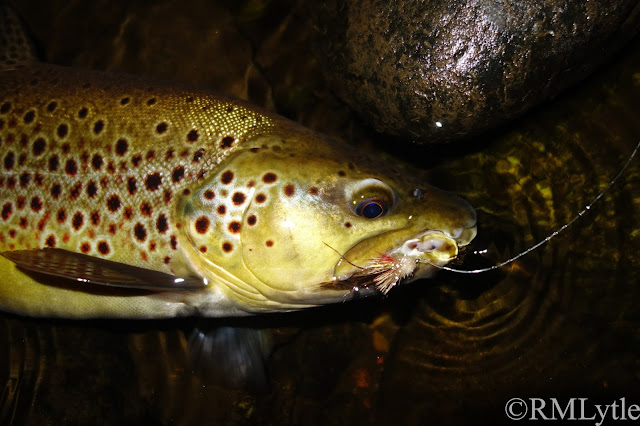If I had to pick one fly to fish for trout at night for the rest of my life, it would be some variation of the classic Muddler. With variations in size and wing material, and adding or removing weight, the Muddler can do pretty much anything I need a night-fishing fly to do. I can imitate a large stonefly nymph or sculpin with a few split shot bouncing the fly along the bottom tightlined. Dressed with floatant and dead drifted or twitched, a small Muddler imitates an insect appropriately. Large, unweighted Marabou Muddlers fished in the film, across stream and with a slow retrieve, does a fantastic job of imitating a rodent or frog. It's true that a simple black Bunny Leech has accounted for the largest trout I've ever caught, and there are times I may have said that was my favorite night fly. But when I'e stopped and thought about it, there's no question, the Muddler covers all the bases.
On a unfortunately well lit night in early September, this fly once again proved it's value. The Farmington was low, the water crystal clear, and the conditions all but assured slow fishing. I was confident that smaller, more subtle presentations would dominate productivity, and there was enough surface activity that I expected good action in the film. I tied on an unweighted size 10 Muddler Minnow and fished it across and down and sometimes across and up, occasionally giving it little twitches but otherwise just maintaining contact. The feed was slow. The first fish to hand was an average rainbow, released quickly. Not what I was looking for. A while later, I registered a gentle take. I lifted the rod into a heavy fish, though one that didn't fight very hard. In my experience, it's either all or nothing. Some night hooked trout hardly fight at all, others put up an excessive show of power and acrobatics. This one was very much one of the former. It was at hand without much fuss at all.
It was a stout fish, a wild brown with girth to spare, though certainly a bit short of 20 inches. Nonetheless, exactly the sort of fish I was looking for.
Time and time again, that simple pattern proves it's worth, be it in daylight or in darkness. The muddler really is a template, not a pattern. That template has morphed into new patterns, from Lou Tabory's Snake Fly to Kelly Galloup's Zoo Cougar. The neutral buoyancy and eddy making capabilities of a spun dear hair head are some of the best tools in a fly tyer's arsenal.
Until next time,
Fish for the love of places fish live.
Fish for you.
And stay safe and healthy.




Man what beautiful browns. Amazing that first one didn't fight that hard. A week ago at dark drifting a hare's ear nymph, I got an unexpected violent hit that nearly stripped line out. That fish went absolutely wild once it realized it was hooked. I don't hook big ones often, but that fish was an outlier for the stream I fish. Oh yes, the barbless hook let go, but at least I felt it on for a brief while.
ReplyDeleteIt doesn't surprise me that this fish didn't fight hard as I've had much, much larger trout fight even less hard at night.
DeleteThat was a beauty of a catch. I like your stile with this tie.
ReplyDeleteTie, fish, write, conserve and photo on...
It's not my style to claim.
DeleteAgree with you 1,000 % on the choice of a muddler for night time fishin'.
ReplyDeleteIt is indeed a killer, for more than trout as well.
Delete